Died 24 November 2003 | ||
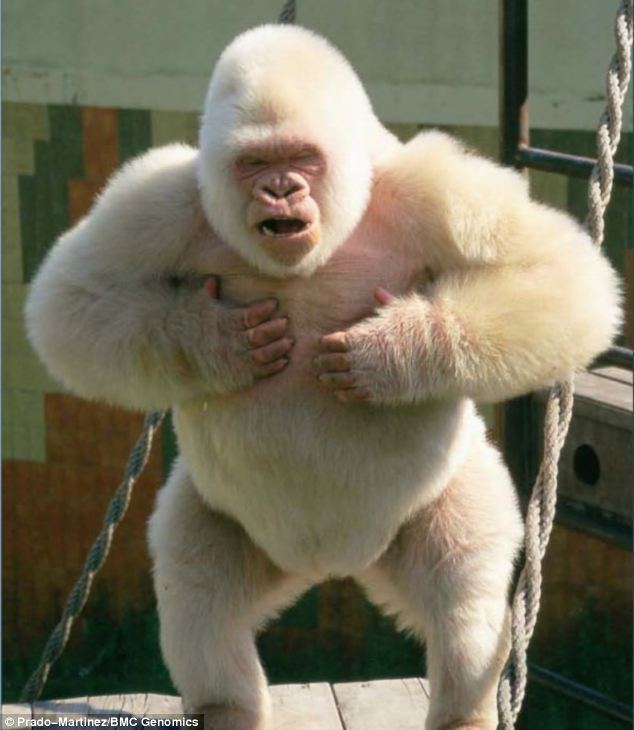 | ||
Snowflake (Catalan: Floquet de Neu, Spanish: Copito de Nieve; c. 1964 – April 10, 2003) was an albino Western lowland gorilla. He was kept at Barcelona Zoo in Spain from 1966 until his death.
Contents
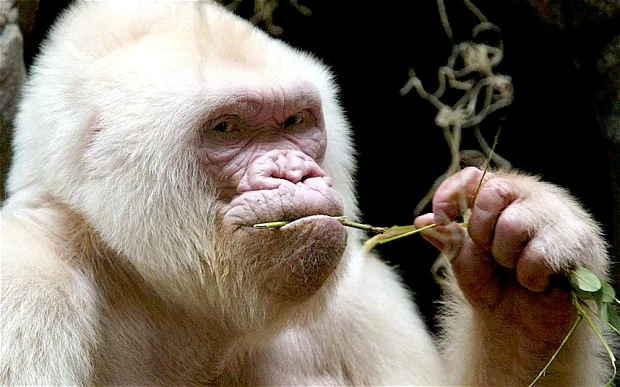
History
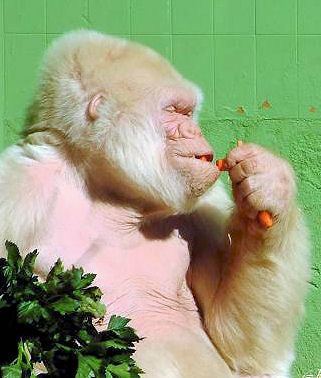
Snowflake was captured in the Rio Muni region in Equatorial Guinea on October 1, 1966 by ethnic Fang farmer Benito Mañé. Mañé had killed the rest of Snowflake's gorilla group (who were normal in color). Mañé then kept Snowflake at his home for four days before transporting him to Bata, where he was purchased by primatologist Jordi Sabater Pi.
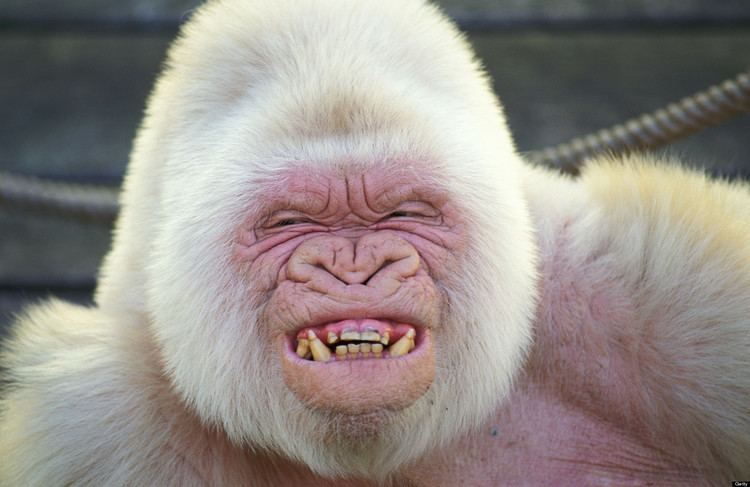
Originally named "Nfumu Ngui" in Fang language ("white gorilla") by his captor, he was then nicknamed "Floquet de Neu" (Catalan for "little snowflake") by his keeper Jordi Sabater Pi.
Characteristics
Snowflake was a Western lowland gorilla with non-syndromic oculocutaneous albinism. Snowflake had unpigmented skin and hair.

Snowflake had poor vision, which is associated with albinism. A test to try to determine whether Snowflake had a central blind spot did not find one. Barcelona Zoo director Antonio Jonch wrote:
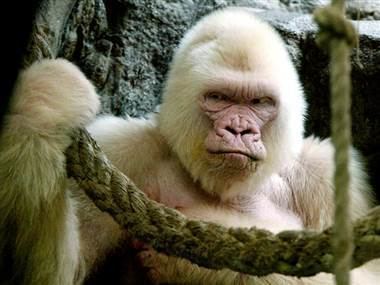
"The eye had a blueish sclera, a normal cornea, and a light blue iris which was very transparent to transillumination. Accommodation and refraction were normal. The media were transparent and the fundus of the eye normal and totally depigmented. The choroidal vessels were perfectly visible and the pupil was normal. The animal displayed marked photophobia which caused it to close its eyes repeatedly when exposed to bright light. In diffuse light similar to that in its biotope, we calculated that it blinked on an average of 20 times a minute."
Study of Snowflake's genome determined that his parents had 12% of their DNA in common, leading researchers to believe that his parents were uncle and niece. The same study revealed that his albinism was caused by a mutation of SLC45A2 gene. Snowflake received the recessive gene from both parents, causing his albinism.
Life in Barcelona
Upon his arrival to Barcelona in November 1966, he was given an official reception by the then Mayor of Barcelona, Josep Maria de Porcioles and called "Blancanieves" ("Snow White") in the newspaper Tele/Exprés. But he became famous with the name given to him by Sabater when National Geographic Magazine featured him on the cover in March 1967, with the English name Snowflake. This name spread among the press (Stern, Life, Paris-Match). Sabater himself called the gorilla "Copi" or "Floquet", and in the later years "Nfumu". He was also known as "Little Buttercup", and as the "Vanilla Gorilla".
At first, the Barcelona Zoo was not aware that Snowflake was a unique specimen. They sent a message to Sabater Pi saying, "Please send more white gorillas." The zoo later hoped to produce a genetic strain and an entire family group of white gorillas through selective breeding. The Barcelona Zoo had a protocol in place to have Snowflake's testicles harvested, upon his death, and placed in the frozen zoo so as to reserve the option of having more offspring from him in the future. Snowflake's genes would have been considered particularly valuable because he was wild caught, and therefore one of the genetic founders to the captive population of Western lowland gorillas, which are endangered, and are being managed by AZA SSP/EEP captive breeding programs for wildlife conservation.
In 1986 the Barcelona Zoo enlisted British zoo veterinarian David Taylor to collect sperm from Snowflake for artificial insemination. Although the attempt was unsuccessful, the story was carried by newspapers the world over.
Offspring
Snowflake fathered twenty-two offspring by three different mates, or "dams". Six of his offspring survived to adulthood. None of Snowflake's offspring were albino, but all should be heterozygous, recessive carriers, for the albino gene. His grandchildren have 50% mathematical probability for carrying the albino gene. If both parents were albino gene carriers they have 25% chance of producing an albino offspring.
As of May 2014, Snowflake has a total of 21 grandchildren (11 survived) and four great-grandchildren (all living). Snowflake's great-grandson N'Kou has pink fingers which is perhaps suggestive of partial albinism.
Death
In 2001, Snowflake was diagnosed with an unusual form of skin cancer, almost certainly related to his albinism condition. By 2003, Snowflake's health began to deteriorate. After he began losing interest in his usual activities, began isolating himself from other gorillas and began exhibiting signs of physical pain, Snowflake's keepers decided to euthanize him. The decision was publicly announced in September 2003. Thousands of people visited Snowflake at the Barcelona Zoo before he was euthanized on November 24, 2003. At the time of his death, Snowflake was thought to be between 38 and 40 years old.
Legacy
The asteroid 95962 Copito, discovered by Spanish astronomer J. Manteca, is named in his honour.
A scholarship for research on primatology was created in memory of and homage to Snowflake. Snowflake's fame also helped to promote awareness of the endangered gorilla species.
The gorilla became a main character in the novel Memòries d'en Floquet de Neu ("Snowflake's Memories") by Catalan writer Toni Sala.
Sabater Pi also dedicated a book to the gorilla, under the title Copito para Siempre (Snowflake Forever).
He also makes a brief appearance in Italo Calvino's novel Mr. Palomar - the passage is a short but beautifully written meditation on loneliness, captivity, the burden of being unique in the world, and mortality.
Nature on PBS devoted an episode to him.
Former U.S. Poet Laureate Billy Collins wrote of Snowflake in his poem, "Searching," published in his 2008 collection, Ballistics.
Snowflake appears on the front cover of dance music act Basement Jaxx's album Rooty.
While playing at FC Barcelona, Dutch football player Ronald Koeman was nicknamed Copito de Nieve because of his blond hair.
Snowflake appeared on The Triplets (Les Tres Bessones) episode "The Triplets meet King Kong" as a guest of honor for the appearance of King Kong in Barcelona's Olympic Stadium.
In 2009 French musician Enzo Enzo released the album Toutim where the song Copito De Nieve De Barcelone is dedicated to Snowflake.
In 2011, there was a live action/CGI film called Snowflake, the White Gorilla that depicts the fictional childhood of Snowflake (voiced by Ariana Grande).
